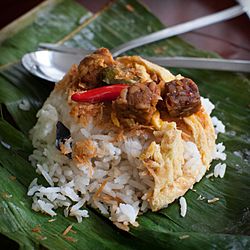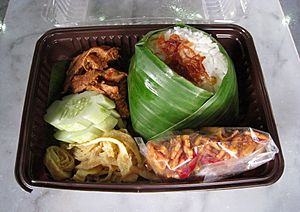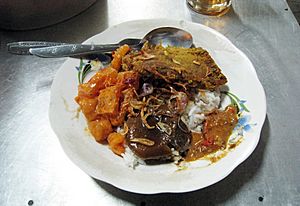Nasi uduk facts for kids

A basic nasi uduk from a shop in the Netherlands
|
|
| Course | Main course |
|---|---|
| Place of origin | Indonesia |
| Region or state | Jakarta, Java |
| Serving temperature | Hot or room temperature |
| Main ingredients | Rice cooked in coconut milk with side dishes |
Nasi uduk is a special Indonesian rice dish. It's made by cooking rice in coconut milk, which gives it a rich, creamy taste. This dish is very popular in Jakarta, especially among the Betawi people.
Contents
What Does "Uduk" Mean?
The word uduk has a few possible meanings. Some people think it comes from an old Indonesian word meaning "difficult" or "struggle." This might suggest that nasi uduk was first eaten by farmers and hard workers.
Another idea is that uduk is related to the word aduk, which means "mix." So, nasi uduk could mean "mixed rice."
In Javanese traditions, the word uduk (or wuduk) might come from an Arabic word, tawadhu'. This word means "being humble before God." In Java, this dish is also called sega gurih, which means "savory rice."
The Story of Nasi Uduk
Nasi uduk is very popular in Jakarta today. But its history might come from two different cooking styles: Malay and Javanese.
From Malacca to Batavia
Historians believe that traders and people from Malacca (in what is now Malaysia) often visited Batavia (which is now Jakarta). They might have brought their way of cooking nasi lemak (a similar coconut rice dish) to Batavia. At the same time, Javanese people living in Batavia also knew how to cook rice with coconut milk.
After the Dutch took over Malacca in 1641, the connection between Malacca and Batavia became even stronger. This helped spread the idea of cooking rice with coconut milk.
A Javanese Idea
Some historians think nasi uduk actually started in Java. They say Sultan Agung of Mataram (a Javanese ruler) created it. He liked "Arabic rice" dishes, like kebuli or biryani. These dishes used expensive ingredients that had to be brought from far away.
Sultan Agung wanted to make a local version of these dishes using ingredients found in Java. This helped save money and made people proud of their own food.
Soon, sega uduk (as it's called in Java) became an important part of Javanese "gratitude" ceremonies. These ceremonies are often called slametan. The rice dish might be given out in a food package called a berkat. Or, it could be shaped into a large cone called a tumpeng and shared after the ceremony. Sega uduk is also eaten during Wiwitan, a ritual before harvesting crops.
Javanese people brought uduk to Batavia in 1628. It quickly became a favorite dish there. People in Batavia who sell nasi uduk often add their own special touch, like semur jengkol (a stew made with stinky beans). Uduk is also popular among Javanese people who live in places like Suriname and the Netherlands.
How Nasi Uduk is Made
Nasi uduk is made by cooking rice in coconut milk instead of plain water. To give it a wonderful smell, spices like clove, cassia bark (like cinnamon), and lemongrass are added. Sometimes, knotted pandan leaves are also put in while the rice steams.
The coconut milk and spices make the rice taste rich and a little oily. Before serving, bawang goreng (fried shallots) are sprinkled on top. Other dishes are usually served on the side.
Serving Styles
Depending on the event, nasi uduk can be served in different ways:
- Berkat style: In a woven bamboo box, or wrapped in teak wood or banana leaves.
- Tumpeng style: As a large cone on a tampah (a round bamboo platter). This is often for ceremonies.
Delicious Side Dishes

Nasi uduk is almost always served with other tasty dishes. For traditional ceremonies, it might come with Javanese foods like:
- Kering tempe (crispy fried tempeh)
- Urap (mixed vegetables with grated coconut)
- Sambel goreng (spicy stir-fried dishes, often with potato, cow's skin, or anchovy)
Simple protein foods like a hard-boiled egg, fried tempeh, or fried tofu are also common.
Today, people might add other Indonesian dishes to nasi uduk, such as:
- Sliced fried egg
- Telur bumbu Bali (Balinese-style egg)
- Rendang (spicy meat stew)
- Mie goreng (fried noodles) or vermicelli
Crispy crackers like Krupuk, rempeyek, or emping are also popular additions.
Jakarta's nasi uduk often mixes Javanese and Malay styles. It might include jengkol (brown stinky beans) as a special Betawi touch. It can also have teri-kacang (fried anchovies and peanuts), which is similar to a Malay nasi lemak side dish.
Sambal (a spicy chili sauce) is often served with nasi uduk when you buy it. You can use any type of sambal you like.
Nasi Uduk in Jakarta
Each area in Jakarta might have its own special version of nasi uduk. For example, Nasi uduk Slipi from West Jakarta is very well-known. The Kebon Kacang area near Tanah Abang in Central Jakarta is also famous for its nasi uduk.
Nasi uduk is a favorite food for busy people in Jakarta because it's usually very affordable. You can find it sold throughout the day. Some street stalls open only in the morning, noon, or night, depending on who lives or works nearby. Stalls near homes, markets, train stations, and schools are often open from morning until noon. Those near offices and main streets usually open from afternoon until midnight.
ja:ナシウドゥッ
See also
 In Spanish: Nasi uduk para niños
In Spanish: Nasi uduk para niños



